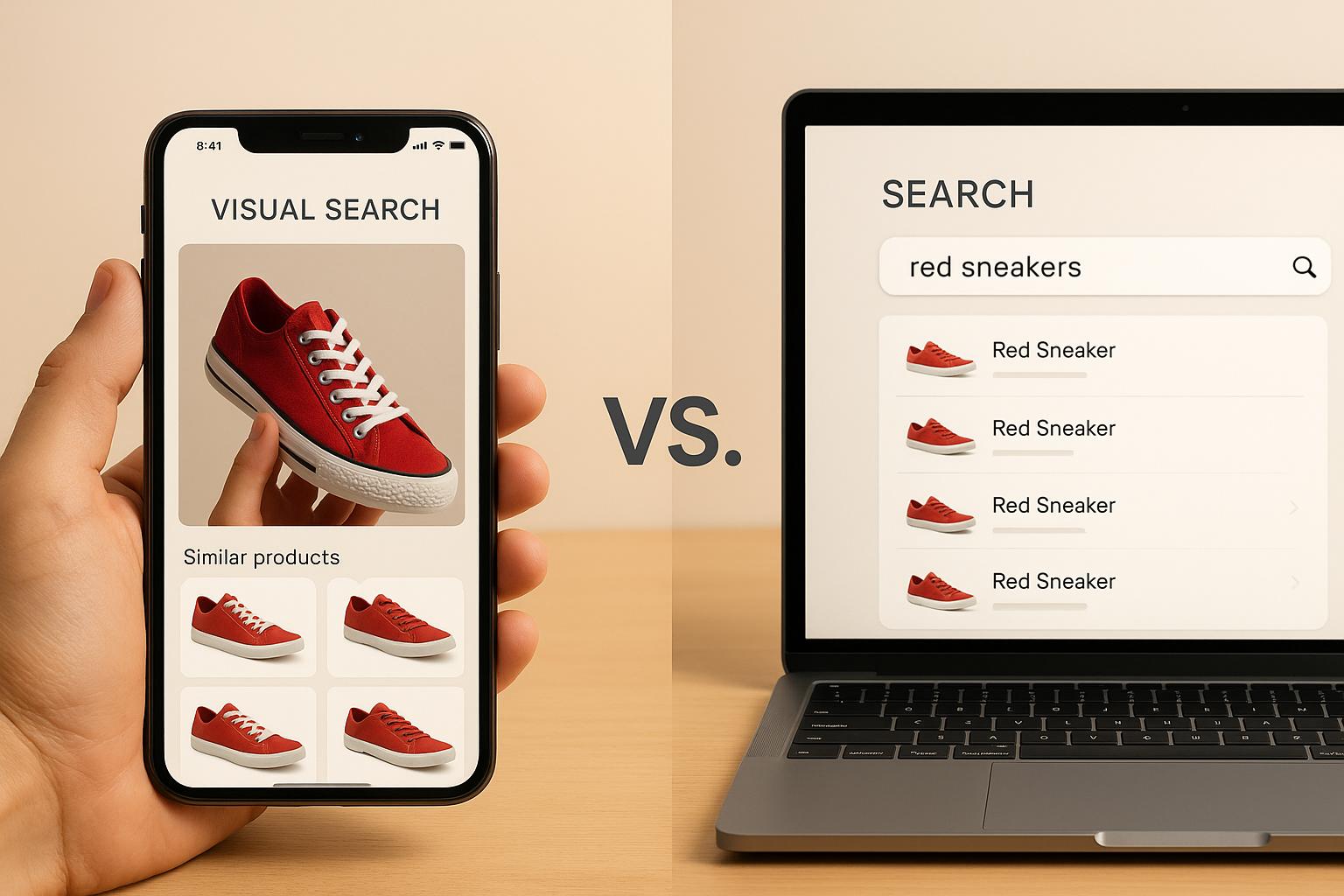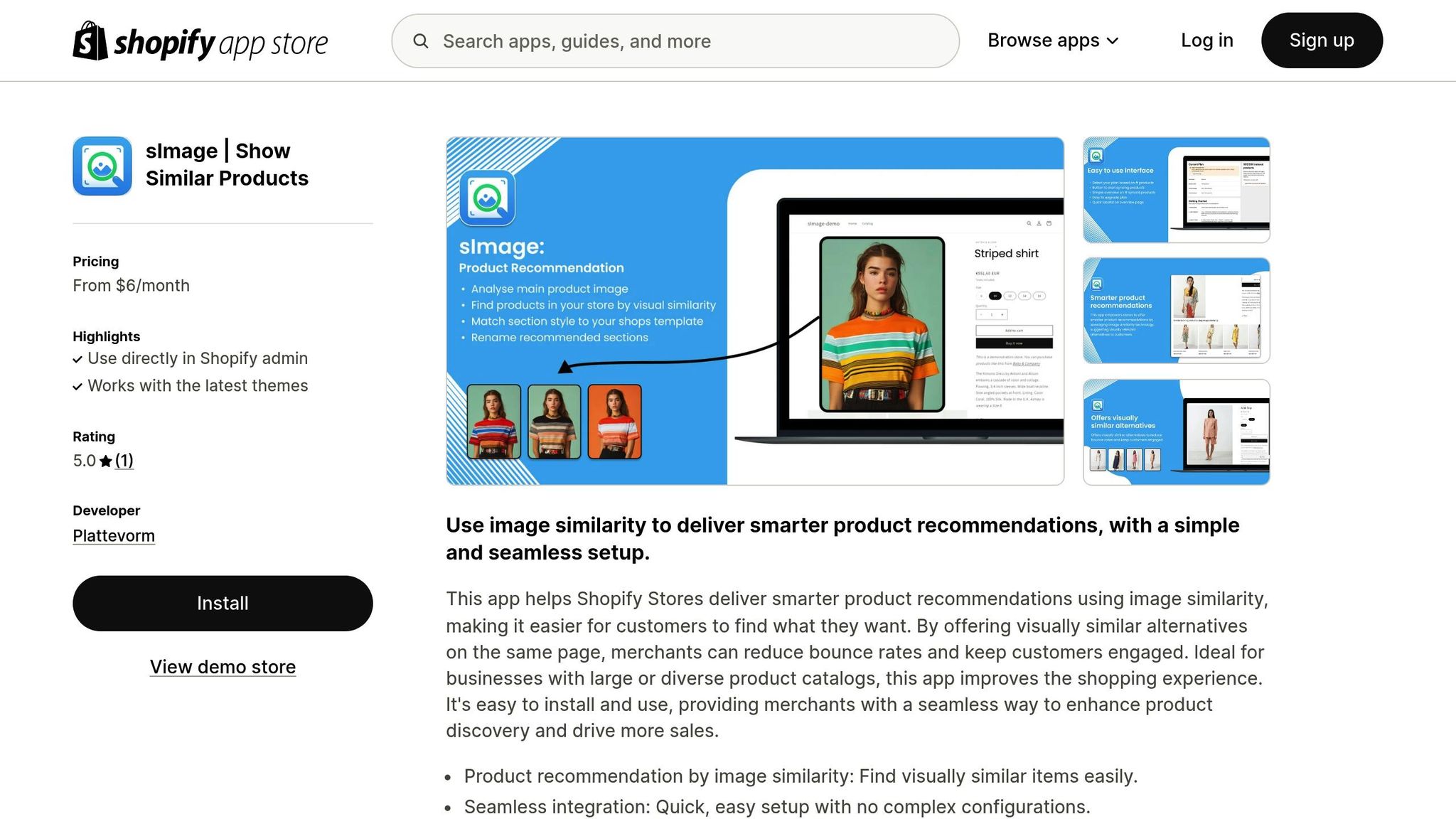AI Visual Search vs. Text-Based Search

AI Visual Search vs. Text-Based Search
AI visual search and text-based search are two ways to help customers find products online. Here’s a quick breakdown:
- AI Visual Search: Upload a photo or screenshot to find similar products. Great for when you can’t describe what you’re looking for. It’s fast, intuitive, and works well for visually-driven items like clothes or furniture.
- Text-Based Search: Type keywords into a search bar to find products. It’s reliable for precise searches like “Nike Air Max size 10” but struggles with vague or misspelled queries.
Quick Comparison
| Feature | AI Visual Search | Text-Based Search |
|---|---|---|
| Input Type | Images, screenshots | Keywords, text |
| Language Dependence | Works across all languages | Requires accurate terms |
| Best For | Visual discovery, inspiration | Precise product searches |
| Checkout Speed | 2x faster | Standard |
| Accuracy | Excels with vague queries | Struggles with imprecise terms |
Both methods have strengths. Combining them can create a better shopping experience, especially for Shopify store owners looking to boost sales and engagement.
AI-Powered Visual Search E-commerce for Fashion
How Text-Based Search Works in Online Stores
Text-based search is straightforward: customers enter keywords, and the system matches them with stored product data. It relies on keywords, structured data, and metadata to connect search queries with product details.
Google defines structured data as:
"A standardized format for providing information about a page and classifying its content."
According to BigCommerce, metadata helps clarify website information for search engines, improving SEO.
Most e-commerce platforms come equipped with basic text search tools. These tools can handle plural forms, correct simple spelling errors, and recognize synonyms included in product tags. By indexing product titles, descriptions, and category structures, the system builds a searchable database that responds to customer queries.
Benefits of Text-Based Search
Text-based search offers clear advantages for online stores. For customers who know exactly what they want, typing something like "Nike Air Max size 10" delivers results quickly. The technology is well-established, dependable, and functions consistently across devices and browsers.
Econsultancy reports that 30% of e-commerce visitors use on-site search, and these users typically have higher purchase intent than casual browsers. An Episerver survey found that conversion rates increase significantly when consumers actively search for products, compared to browsing social media or viewing display ads.
Another strength of text-based search is precision matching. When product catalogs are properly labeled and organized, the system can deliver exactly what customers are looking for. Advanced search features - such as filters for price, brand, color, and ratings - help users quickly narrow down their options to find the perfect item.
The impact of optimizing structured data is well-documented. In 2025, several companies reported major gains:
- Rotten Tomatoes added structured data to 100,000 pages and saw a 25% higher click-through rate for enhanced pages.
- The Food Network enabled search features on 80% of their pages, resulting in a 35% increase in visits.
- Rakuten found users spent 1.5x more time on pages with structured data and engaged 3.6x more with enhanced pages.
- Nestlé reported that pages appearing as rich results in search had an 82% higher click-through rate than standard pages.
While text-based search has clear strengths, it also comes with notable challenges for both shoppers and store owners.
Problems with Text-Based Search
Despite its reliability, text-based search has significant limitations. The biggest issue? Rigid language requirements. A study by the Baymard Institute found that 61% of e-commerce sites require users to use exact product terminology. For example, if your site lists "sofa" but customers search for "couch", they might not find relevant results.
This issue goes beyond terminology mismatches. Baymard's research uncovered several gaps in search capabilities that hurt user experience:
- 46% of sites don’t support thematic searches like "spring jacket" or "office chair".
- 32% can’t handle basic symbols or abbreviations.
- 27% fail with single-character misspellings in product titles.
- 25% don’t support non-product queries like "returns" or "order tracking".
These shortcomings frustrate customers. Research shows that 69% of consumers report seeing irrelevant results, and 81% of e-commerce websites display unrelated items even for simple two-word queries. The consequences for user experience are clear:
| Search Problem | % of Frustrated Consumers |
|---|---|
| Irrelevant results being shown | 41% |
| Out-of-stock products in results | 32% |
| Lack of appropriate filters | 30% |
| Slow loading results | 27% |
| Can’t interpret queries (synonyms, typos) | 26% |
The business impact is significant. 80% of shoppers leave due to poor search experiences, leading to substantial revenue losses. This is especially concerning given that search users are 2.4 times more likely to make a purchase, and retailers with advanced search capabilities see desktop conversion rates that are double those of basic search systems.
Other challenges add to these issues. With 75% of site search queries being new each month, traditional text-based search struggles to keep up with changing customer language and discovery habits. It also performs poorly with complex, multi-word queries - one-third of searches contain four or more keywords - and the 20-30% of queries that include misspellings.
These limitations are driving retailers to explore better search technologies that align more closely with evolving customer behavior.
How AI Visual Search Works
AI visual search is reshaping how people discover products by using computer vision instead of relying on keywords. Here’s how it works: when a shopper uploads an image - be it a social media screenshot, an in-store photo, or something found online - the system analyzes the picture using computer vision to identify key visual elements like colors, shapes, textures, and patterns.
This process eliminates the need for precise keyword input. Instead, the AI extracts these visual features and matches them to products in its database. It’s a game-changer for situations where customers see something they like but don’t know how to describe it. Amanda Milberg, Data Scientist at Dataiku, sums it up perfectly:
"Visual search is helpful when you're uncertain of the name of what you're searching for. The power of visual search enables an individual to simply screenshot an image, upload it to a search engine, and retrieve results on where to purchase."
Next, let’s dive into the technology that makes this possible.
Core Technologies Behind AI Visual Search
At the heart of AI visual search lies some impressive technology. Computer vision allows algorithms to scrutinize images and pull out details like color, texture, and shape. Deep learning, particularly through Convolutional Neural Networks (CNNs), processes these images layer by layer, identifying even the smallest visual details. Machine learning refines the system over time, improving its ability to spot patterns as it interacts with users. Meanwhile, image recognition algorithms classify objects by comparing visual features against massive image datasets.
The market for visual search is growing fast, with a projected CAGR of over 17% through 2030. Pinterest’s success highlights its popularity - within a year of launching its visual search engine, the platform recorded over 600 million visual searches per month.
Practical Use for Shopify Store Owners

For Shopify merchants, visual search is more than just a neat feature - it’s a powerful tool to increase engagement and sales, especially for shoppers seeking inspiration. Big retailers have already shown how effective it can be. For instance, in 2025, H&M’s mobile app allowed users to upload photos and find similar items, with AI-powered styling tools suggesting outfits tailored to their preferences, past purchases, and the latest trends. Amazon’s StyleSnap uses similar technology to analyze outfit photos, offering recommendations based on color, fit, and style. IKEA’s app takes it a step further with its "Place" feature, blending visual search with augmented reality to let customers see how furniture would look in their homes.
The results speak for themselves. CCC Group, for example, saw its conversion rate quadruple compared to traditional keyword searches after adopting visual search. Michal Pachnik, head of ecommerce campaigns and mobile apps at CCC Group, explained:
"Visual search is changing the way people interact with e-commerce, especially considering current consumer behaviour trends."
Shopify store owners can easily tap into this technology using tools like sImage, which makes AI-powered image analysis accessible without requiring technical skills. sImage suggests visually similar products within the store, creating new cross-selling opportunities and enhancing the shopping experience. It integrates smoothly with Shopify themes and requires no coding for setup. To maximize results, merchants should prioritize high-quality product images with clear backgrounds and multiple angles. These details help the AI work more effectively, leading to better matches and higher conversion rates compared to traditional search methods.
sbb-itb-521eef9
AI Visual Search vs Text-Based Search: Side-by-Side Comparison
Let’s dive into how AI visual search stacks up against text-based search in real-world scenarios. The differences between these two approaches go beyond just technology - they reshape how customers interact with online stores.
| Feature | AI Visual Search | Text-Based Search |
|---|---|---|
| Search Input | Images, photos, screenshots | Keywords, text descriptions |
| Language Dependency | Works across all languages | Requires accurate vocabulary |
| Product Discovery | Driven by inspiration and visual matching | Based on intent and keyword matching |
| User Experience | Intuitive; no need for detailed descriptions | Depends on users’ ability to describe their needs |
| Conversion Speed | 2x faster checkout process | Follows a standard timeline |
| Accuracy with Vague Queries | Excels with incomplete or unclear details | Struggles with imprecise terms |
| Cross-selling Potential | High, using visual similarity | Limited to keyword-based suggestions |
These contrasts highlight how each method creates a unique shopping experience.
User Experience Differences
How customers engage with these search methods varies significantly. AI visual search eliminates the frustration of trying to describe what you see. For example, if someone spots a trendy outfit on social media but doesn’t know terms like "flounce" or "peplum", they can simply upload a photo to find similar items. This ease of use works globally, whether the shopper is in Japan, Germany, or the U.S..
In fact, 62% of millennials and Gen-Z shoppers favor visual search over traditional text-based methods. While text-based search is effective for users who know exactly what they’re looking for, it often falls short when inspiration strikes. Visual search bridges this gap, offering a seamless way to match customer intent for visually driven products. These advantages naturally lead to better sales outcomes, as we’ll explore below.
Impact on Sales Performance
The effect on sales is both clear and measurable. Visual search can cut checkout times in half, largely by removing the back-and-forth of refining keywords and sifting through irrelevant results.
It also boosts engagement by keeping customers on a retailer’s site longer. More time spent browsing means more opportunities for cross-selling and upselling. For instance, BooHoo saw an 85% higher conversion rate among users who used Camera Search, while Forever 21 increased average order values by 20% through visual commerce.
When it comes to vague or ambiguous queries, AI visual search consistently outperforms text-based methods. In one study, AI search outclassed Elasticsearch in 35 different queries, showing particular strength with longer or less specific searches. For example, a search for "women sandals white straps" in visual search returned only sandals with white straps, while text-based search produced a broader, less relevant set of results.
Looking ahead, visual search is expected to increase online retail revenue by up to 30% by 2025. This growth is driven by higher conversion rates, fewer abandoned carts, and happier customers. Tools like sImage make it simple for Shopify stores to tap into these benefits, turning casual browsers into committed buyers without any technical headaches.
Setup Guide for Shopify Stores
Getting your Shopify store's search functionality up and running doesn't have to be complicated. Here's a breakdown of how to implement both text-based and visual search methods for your store.
Technical Setup Requirements
For text-based search, start by installing a Shopify app designed to index your product names, descriptions, and tags. These apps crawl through your catalog, creating a searchable database. To maximize effectiveness, make sure your product details are enriched with relevant keywords.
On the other hand, visual search requires a bit more preparation. Since Shopify doesn't natively support this feature, you'll need to use a third-party app to integrate visual search technology. Start by optimizing your product images with metadata and ensure they're high-quality and clear. Once integrated, the AI-powered system will analyze and classify your product catalog. These tools can process thousands of items quickly, often within hours, saving you significant time and effort.
Benefits of AI Tools Like sImage

To simplify the process of integrating visual search, tools like sImage are a fantastic option. sImage offers a no-code integration that seamlessly works with your Shopify theme. Once installed, it immediately analyzes your entire product catalog, making visual search accessible without requiring advanced technical skills.
One of the standout features of sImage is its flexible pricing, making it a great choice for U.S.-based merchants. For smaller stores, the free plan supports up to 100 products with unlimited monthly searches - perfect for testing the waters. As your store expands, you can upgrade to plans starting at $6/month for up to 500 products. For larger catalogs, options go up to 8,000 products, with custom enterprise solutions available for even bigger operations.
Another advantage of sImage is its automation. As you add new products to your store, the tool continuously refines its visual search capabilities. This reduces the need to constantly update text-based descriptions or tweak keywords, freeing up your time to focus on other aspects of your business.
Conclusion: Which Search Method Is Right for Your Shopify Store
When deciding between AI visual search and text-based search, the best strategy for most Shopify merchants is to integrate both. This combination creates a well-rounded search experience that caters to diverse customer needs.
Text-based search is essential for shoppers who know exactly what they’re looking for. It’s effective across all product categories, especially for straightforward searches. However, it can fall short when customers struggle to describe items or face language barriers.
On the other hand, AI visual search shines when customers are drawn to an image but can’t put their inspiration into words. Research shows that 62% of millennials and Gen-Z shoppers prefer visual search, and these users tend to complete purchases twice as quickly. As Wanda Gierhart, Chief Marketing Officer at Neiman Marcus, puts it:
"Visual search removes hurdles, taking the customer directly from inspiration to gratification."
These differences highlight why combining both methods is a smart move. Together, they address a broader range of shopping behaviors. In fact, over 85% of online shoppers prioritize visual information over text when browsing for items like clothing or furniture.
For Shopify store owners, the choice often depends on your product catalog and target audience. If your products rely heavily on visual appeal - like fashion or home decor - adding visual search tools such as sImage can drive significant results. For instance, LOZURI, a luxury fashion retailer, saw a 38% increase in overall conversion rates and a 40% boost in revenue per visitor after implementing visual search functionality.
The numbers support this hybrid approach. The visual search market is projected to hit $33 billion by 2028, growing at a compound annual rate of 17.5%. By adopting both search methods, you’re not just meeting today’s customer expectations - you’re also preparing for the future of e-commerce.
Take a moment to analyze your store’s search performance. If you notice high bounce rates, it could signal that text-based search alone isn’t cutting it. Visual search might be the missing piece to bridge that gap and keep your customers engaged.
FAQs
How does AI visual search enhance the shopping experience compared to text-based search?
AI visual search is changing how people shop by letting them use images to find products instead of typing out keywords. This is especially handy in areas like fashion and home decor, where visual appeal and details are key to making choices.
With advanced image recognition technology, visual search provides precise and user-friendly results. It eliminates the hassle of mismatched keywords, makes shopping more interactive, and even suggests tailored product recommendations. The result? A smoother shopping experience that leaves customers happier and encourages more sales.
What do I need to set up AI visual search in my Shopify store?
Setting up AI visual search in your Shopify store is simple and hassle-free. Many apps, such as sImage, are built to work smoothly with Shopify, and the best part? You don’t need any coding skills. Just install the app directly from your Shopify admin, and it will take care of tasks like analyzing images and generating product recommendations automatically.
These tools often include features like allowing customers to upload images or select products, which then suggest visually similar items. This not only makes shopping more engaging but also opens up more opportunities for cross-selling.
How does combining AI visual search with text-based search benefit online retailers?
Integrating AI visual search with traditional text-based search transforms how customers shop by making the experience smoother and more tailored. Visual search lets users upload an image to instantly find products that match or resemble it, removing the hassle of coming up with the perfect search terms. This makes discovering products easier, especially for shoppers who might struggle to describe what they’re looking for in words.
Pairing visual search with text-based search gives retailers a powerful way to help customers navigate their catalog more naturally. This combination not only improves customer satisfaction but also opens up cross-selling opportunities and boosts sales by catering to different shopping habits and preferences.